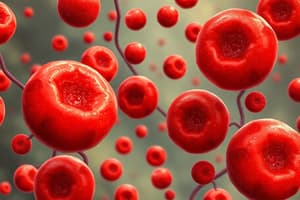Podcast
Questions and Answers
What is the primary function of red blood cells?
What is the primary function of red blood cells?
- Transporting nutrients from the digestive system to the body tissues
- Producing antibodies to fight against infections
- Transporting oxygen from lungs to tissues and carbon dioxide from tissues to lungs (correct)
- Regulating body temperature
Which vitamin is essential for red blood cell maturation?
Which vitamin is essential for red blood cell maturation?
- Vitamin A
- Vitamin C
- Vitamin D
- Vitamin B12 (correct)
What is the condition characterized by an excess of red blood cells, leading to thicker blood?
What is the condition characterized by an excess of red blood cells, leading to thicker blood?
- Anemia
- Leukopenia
- Polycythemia (correct)
- Hemophilia
What causes sickle-cell anemia?
What causes sickle-cell anemia?
What is the primary function of red blood cells?
What is the primary function of red blood cells?
Why must hemoglobin remain inside red blood cells in humans?
Why must hemoglobin remain inside red blood cells in humans?
What is the enzyme present in red blood cells that catalyzes the reaction between CO2 and water?
What is the enzyme present in red blood cells that catalyzes the reaction between CO2 and water?
What is the primary function of carbonic anhydrase in red blood cells?
What is the primary function of carbonic anhydrase in red blood cells?
What is the average diameter of a normal red blood cell?
What is the average diameter of a normal red blood cell?
What is the average volume of a red blood cell?
What is the average volume of a red blood cell?
In healthy men, what is the average number of red blood cells per cubic millimeter?
In healthy men, what is the average number of red blood cells per cubic millimeter?
What is the average percentage of hemoglobin in each red blood cell in normal people?
What is the average percentage of hemoglobin in each red blood cell in normal people?
What is the normal hematocrit percentage in healthy individuals?
What is the normal hematocrit percentage in healthy individuals?
How much oxygen can be carried in combination with hemoglobin in a normal man's blood?
How much oxygen can be carried in combination with hemoglobin in a normal man's blood?
Flashcards are hidden until you start studying
Study Notes
- Red blood cells, also known as erythrocytes, are disc-shaped cells responsible for transporting oxygen from lungs to tissues and carbon dioxide from tissues to lungs, acting as acid-base buffers.
- Red blood cells lack a nucleus and contain hemoglobin, a protein responsible for oxygen transportation.
- Anemia occurs when there is a deficiency of red blood cells or hemoglobin, leading to reduced oxygen supply to body tissues.
- Polycythemia, also known as polycythemia vera, is a condition with an excess of red blood cells, leading to thicker, more viscous blood.
- Red blood cells are produced from stem cells, called colony-forming unit-erythrocytes (CFU-Es), in the bone marrow and develop into reticulocytes before maturing into erythrocytes.
- Humans produce red blood cells throughout their life, with production shifting from the liver to the bone marrow after birth.
- Regular adult production of red blood cells is carried out by the vertebrae, sternum, and ribs.
- Vitamin B12 and folic acid are essential for red blood cell maturation.
- Pernicious anemia results from a deficiency of these vitamins, leading to immature and fewer red blood cells.
- Hemoglobin synthesis occurs in the proerythroblasts and continues through reticulocyte development.
- Iron is required in the heme group of hemoglobin for oxygen binding.
- Sickle-cell anemia, a genetic disorder, results from a mutation in one of the amino acids of hemoglobin, causing red blood cells to take on a sickle shape.
- Iron is absorbed in the gastrointestinal tract, and a deficiency can lead to anemia due to inadequate red blood cell production.
- Red blood cells have a lifespan of approximately 120 days and are recycled through the spleen when destroyed.
- Disorders of red blood cells include anemia due to blood loss, bone marrow dysfunction, vitamin deficiencies, immune conditions, and inherited genetic conditions.
- Anemia results in a reduced blood viscosity, while polycythemia, an excess of red blood cells, increases blood viscosity and can lead to clots and other complications.
Studying That Suits You
Use AI to generate personalized quizzes and flashcards to suit your learning preferences.




